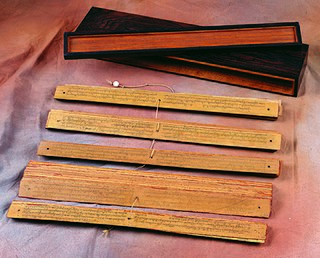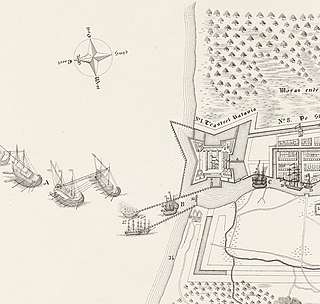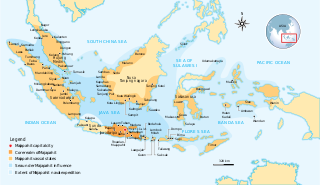
The Baju Rantai (also known as Badjoe-Rante, Baju Besi, Baju Rante, Wadjoe-Rante, and Waju Rante) is a type of armor from Nusantara archipelago (Indonesia, Malaysia, Brunei, and Philippines).

The Baju Rantai (also known as Badjoe-Rante, Baju Besi, Baju Rante, Wadjoe-Rante, and Waju Rante) is a type of armor from Nusantara archipelago (Indonesia, Malaysia, Brunei, and Philippines).
The name originates from old Javanese words, baju comes from waju meaning jacket, clothing or apparel, [1] : 2174 meanwhile rantai comes from rante, rantay, or ranti which mean chain, string, or wreath. [1] : 1504
The Baju Rantai is a chain armor that is worked in the form of a shirt. It consists of small iron rings. It has no collar and sleeves that reach about to the elbow. The lower end is approximately at the height of the thighs. It is used by various ethnic groups in Indonesia. [2]


One of the earliest mention of Baju Rantai is in KidungPanji Wijayakrama-Rangga Lawe, a javanese kidung text that tells about the rebellion of Rangga Lawe against Majapahit in 1295 A.D.. The name in the text is waju rante, which means apparel consisting of iron chains. Zoetmulder noted the use of special apparel for soldiers: In his research about old Javanese he found a troops called bala winaju gangsa ranti, [3] : 1370 which means soldier dressed with gangsaranti. Gangsa (from sanskrit: kangśa) refers to a kind of copper and lead alloy, [3] : 275 while ranti means chain. [3] : 919
The Hikayat Banjar noted the Bhayangkara equipments in the Majapahit palace, which includes:
Maka kaluar dangan parhiasannya orang barbaju-rantai ampat puluh sarta padangnya barkupiah taranggos sakhlat merah, orang mambawa astenggar ampat puluh, orang mambawa parisai sarta padangnya ampat puluh, orang mambawa dadap sarta sodoknya sapuluh, orang mambawa panah sarta anaknya sapuluh, yang mambawa tumbak parampukan barsulam amas ampat puluh, yang mambawa tameng Bali bartulis air mas ampat puluh.
So came out with their ornaments men with chain mail numbered forty alongside their swords and red kopiah [skull cap], men carrying astengger [ arquebus] numbered forty, men carrying shield and swords numbered forty, men carrying dadap [a type of shield] [lower-roman 1] and sodok [broad-bladed spear-like weapon] [lower-roman 2] numbered ten, men carrying bows and arrows numbered ten, (men) who carried parampukan spears [lower-roman 3] embroidered with gold numbered forty, (men) who carried Balinese shields with golden water engraving numbered forty.
— Hikayat Banjar, 6.3 [9] : Line 1209–1214 [10] : 204–205
Two related ethnic communities of South Sulawesi, the Bugis and Makassarese, also adopted chain mail armor which they call as waju rante or waju ronte. The armor is made by string of iron rings tied together, which makes it similar to knitwork. [11] : 39 The Bugis and Makassarese soldiers were known for using chain mail and muskets which they made themselves. [12] : 431

Majapahit, also known as Wilwatikta, was a Javanese Hindu-Buddhist thalassocratic empire in Southeast Asia that was based on the island of Java. It existed from 1293 to circa 1527 and reached its peak of glory during the era of Hayam Wuruk, whose reign from 1350 to 1389 was marked by conquests that extended throughout Southeast Asia. His achievement is also credited to his prime minister, Gajah Mada. According to the Nagarakretagama written in 1365, Majapahit was an empire of 98 tributaries, stretching from Sumatra to New Guinea; consisting of present-day Indonesia, Singapore, Malaysia, Brunei, southern Thailand, Timor Leste, southwestern Philippines although the scope of Majapahit sphere of influence is still the subject of debate among historians. The nature of Majapahit relations and influences upon its overseas vassals, and also its status as an empire are still provoking discussions.
Old Javanese or Kawi is the oldest attested phase of the Javanese language. It was spoken in the eastern part of what is now Central Java and the whole of East Java, Indonesia. As a literary language, Kawi was used across Java and on the islands of Madura, Bali and Lombok. It had a sizable vocabulary of Sanskrit loanwords but had not yet developed the formal krama language register, to be used with one's social superiors that is characteristic of modern Javanese.

Gajah Mada, also known as Jirnnodhara, was a powerful military leader and Mahapatih of the Javanese empire of Majapahit during the 14th century. He is credited in Old Javanese manuscripts, poems, and inscriptions with bringing the empire to its peak of glory.

Petrus Josephus Zoetmulder S.J. was a Dutch expert in the Old Javanese language. He came from Utrecht and was associated with the Society of Jesus by 1925. He worked at Leiden University in the 1930s. His first work appeared in 1930 and he continued to write into the 1990s. He lived in Yogyakarta and was interred in the Jesuit necropolis at Muntilan, Java.

The Nagarakretagama or Nagarakṛtāgama, also known as Desawarnana or Deśavarṇana, is an Old Javanese eulogy to Hayam Wuruk, a Javanese king of the Majapahit Empire. It was written on lontar as a kakawin by Mpu Prapanca in 1365. The Nagarakretagama contains detailed descriptions of the Majapahit Empire during its greatest extent. The poem affirms the importance of Hindu–Buddhism in the Majapahit empire by describing temples and palaces and several ceremonial observances.

Kakawin Hariwangsa is an Old Javanese poem in Indian metres which tells the story of Krishna, as an Avatar of Vishnu, when he wished to marry the Goddess Rukminī, from the land of Kundina, and daughter of Lord Bhishmaka. Rukmini is an avatar of the goddess Śrī.
Kakawin are long narrative poems composed in Old Javanese, also called "Kawi", written in verse form with rhythms and meters derived from Sanskrit literature. Poets used a formalized literary language, rather than the vernacular. Poets composed and performed the poems at the courts of central and east Java kings between the 9th and 16th centuries, and in Bali.

The songkok or peci or kopiah is a cap widely worn in Brunei, Indonesia, Malaysia, Singapore, the southern Philippines, and southern Thailand, most commonly among Muslim males. It has the shape of a truncated cone, usually made of black or embroidered felt, cotton or velvet. It is also worn by males in formal occasions such as weddings and funerals or festive occasions such as the Eid ul-Fitr and Eid al-Adha holidays. In Indonesia, the peci is also associated with the nationalist movement.
Kakawin Sutasoma is an Old Javanese poem in poetic meters. It is the source of the motto of Indonesia, Bhinneka Tunggal Ika, which is usually translated as Unity in Diversity, although literally it means '(Although) in pieces, yet One'. It is not without reason that the motto was taken from this kakawin as the kakawin teaches religious tolerance, specifically between the Hindu and Buddhist religions.
Javanese literature is, generally speaking, literature from Java and, more specifically, from areas where Javanese is spoken. However, similar with other literary traditions, Javanese language works were and not necessarily produced only in Java, but also in Sunda, Madura, Bali, Lombok, Southern Sumatra and Suriname. This article only deals with Javanese written literature and not with oral literature and Javanese theatre such as wayang.
The Battle of Bubat also known as Pasunda Bubat is the battle between the Sundanese royal family and Majapahit army that took place in Bubat square on the northern part of Trowulan in 1279 Saka or 1357 CE.

Malangbang or melambang is a type of medieval sailing ship from Indonesia. It is mentioned mainly in the History of Banjar. The name "malangbang" is considered to originate from the Old Javanese language, malabong (malaboṅ) which refers to a particular type of boat. Malangbang is one of Majapahit's main naval vessel types after jong and kelulus. Not much is known about this type of ship, apart from the fact that it also used oar beside the sails to propel it, broad and flat-bottomed, and was a "medium-sized" ship, between the size of jong and kelulus, larger and faster than pilang (pelang).

Pelang or pilang is a traditional boat from Indonesia and Malaysia. It may refer to several different types of boats in the Nusantara, but commonly they refer to an outrigger canoe. The function differs from where they were used, from transporting people, fishing, to trading. Pilang has been known from at least the 14th century.

Ghurab or gurab is a type of merchant and warship from the Nusantara archipelago. The ship was a result of Mediterranean influences in the region, particularly introduced by the Arabs, Persians, and Ottomans. For their war fleet, the Malays prefer to use shallow draught, oared longships similar to the galley, such as lancaran, ghurab, and ghali. This is very different from the Javanese who prefer long-range, deep-draught round ships such as jong and malangbang. The reason for this difference is that the Malays operated their ships in riverine water, sheltered straits zone, and archipelagic environment, while the Javanese are often active in the open and high sea.

Baru Öröba is a traditional armor of the Nias people in Indonesia. The earliest examples of this type of armor were made out of crocodile skin. After crocodile can no longer be found on Nias, the material is replaced with hammered metal.
Mpu Tantular was a famous Javanese poet of Javanese literature who lived in the 14th century, during the reign of king Hayam Wuruk. Tantular was a Buddhist, and was respectful to other religions. This can be seen in two items of kakawin or poetry, the Kakawin Arjunawijaya and Kakawin Sutasoma. One of the verses from the Kakawin Sutasoma was later taken as the motto or motto of the Republic of Indonesia: "Bhinneka Tunggal Ika" or different but one.

Karambalangan is a type of personal armor from Java. It is a metal coating worn in front of the chest or breastplate.

Kawaca is a term for war attire mentioned in Old Javanese texts. Its name comes from the Sanskrit kawaca which means armor, cuirass, a type of chain mail, any kind of cover, corset, jacket.

Siping-siping, simping-simping, or sisimping, is a type of armor used in Java. It is a short sleeveless jacket made of scale-shaped metal plates.

According to the Kakawin Nagarakretagama canto XIII and XIV, the following areas are recognized as conquered or subordinate to Majapahit. The conquered states in Java were not mentioned because they were still considered part of the royal "mandala".